The Ria Formosa Natural Park is a stunning lagoon paradise that extends for nearly 60 kilometers (around 40 miles) along Portugal’s southeastern coast. This natural wonder is made up of a network of islands, sandbars, lagoons, canals, and marshes that shift in size and shape with the currents and tides. You can access its diverse array of landscapes and habitats, by hiking, cycling, swimming, or by public ferries and boats. The Ria Formosa park is a must-visit for anyone traveling to the Algarve.
A Stunning Natural Lagoon
The Ria Formosa features six barrier islands and a peninsula, all boasting beautiful white sand beaches, some of these islands are actually completely deserted. As a protected natural park, development in the Ria Formosa is controlled, which means there’s a lack of significant development here. You won’t find large beachfront hotels, apartment complexes or massive resorts here. it results in a mixture of traditional and historic towns, local atmosphere, and of course natural beauty. That’s not to say you won’t find large resorts or tourist complexes, but they are largely restricted to the bigger towns along the way. Like Faro, Olhão and Tavira.
These beaches and islands are perfect for those seeking peace and quiet, with some even officially recognized as nude beaches. The natural park is also haven of local and migratory wildlife. Visitors can spot a variety of wildlife, including chameleons, seahorses, flamingos, storks, and other resident and migratory birds.
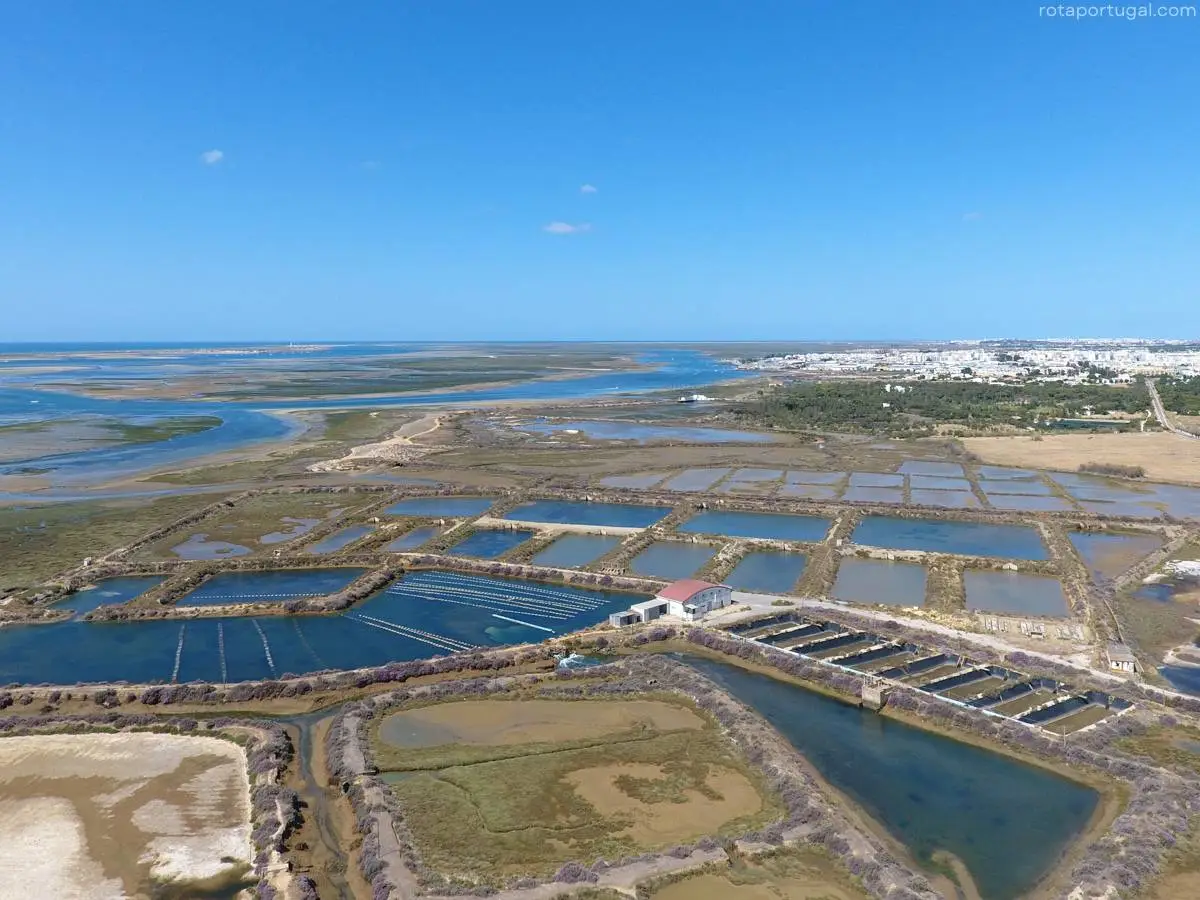
Main Gateways to the Ria Formosa: Faro, Olhão, and Tavira
The primary gateways to the beaches on the islands are the cities of Faro, Olhão, and Tavira. From their marinas, piers, and docks, you can hop on tourist boats for tours around the lagoon, or take a public ferries directly to the islands and beaches. Additionally all three have walking trails, so if the adventure of a boat trip doesn’t appeal to you, its still very easy to access and explore the Ria Formosa.
Read More: Olhão – The Gateway to the Ria Formosa
The Best Beaches and Islands to visit in the Ria Formosa
So how do you choose somewhere in the incredible park to visit and which island should you choose? Here’s my personal favourite places you should consider!
Praia de Cacela Velha
Located at the far eastern end of the Ria Formosa, Praia de Cacela Velha is a pristine beach accessed by boat at high tide or on foot during low tide.
The beach itself is located just a short walk from the village of Cacela Velha. A remarkably well preserved village boasting a fortress, church and many historic Algarvean houses. However, most of the visitors are here for the incredible beach! This beautiful stretch of sand boasts shallow and calm waters, and the gently snaking Ria Formosa’s channels. Praia de Cacela Velha is of course a blue flag beach, boasting clean waters, life guards during bathing season, and has been ranked among the Europe’s best beaches.

Ilha de Cabanas de Tavira
This 7-kilometer-long (4 miles) beach lies between Cacela Velha and Tavira and can be reached by a short boat ride from the small village of Cabanas de Tavira. Ilha de Cabanas is the first of the Ria Formosa’s barrier islands if you’re travelling from east to west. Ilha de Cabanas offers plenty of space, and freedom to enjoy the open space of the natural park. It is one of the least developed islands, with no permanent community or overnight accommodation. During the summer you’ll find one restaurant, and one small bar at the beach. The rest of the island is a one long stretch of dunes and beach, perfect for beach walks or taking in both sides of the Ria Formosa – the lagoon side, and the ocean facing side.

Praia da Ilha de Tavira
Ilha de Tavira is the second barrier island travelling from east to west, and it’s also uninhabited. Although it is more developed, you’ll find a few more restaurants and even a camping site for overnight visitors. Ilha de Tavira is officially divided into four beach areas, Praia da Ilha de Tavira is easily accessible from Tavira’s town center via a regular ferry.
During the summer families flock to Praia da Ilha de Tavira from Tavira as its one of the simplest to access, has variety of restaurants, and even sports facilities like volleyball nets. However, if you prefer a more peaceful experience, you can head west of the main beach and find your own space, as the island is nearly 10km (7 miles) long.
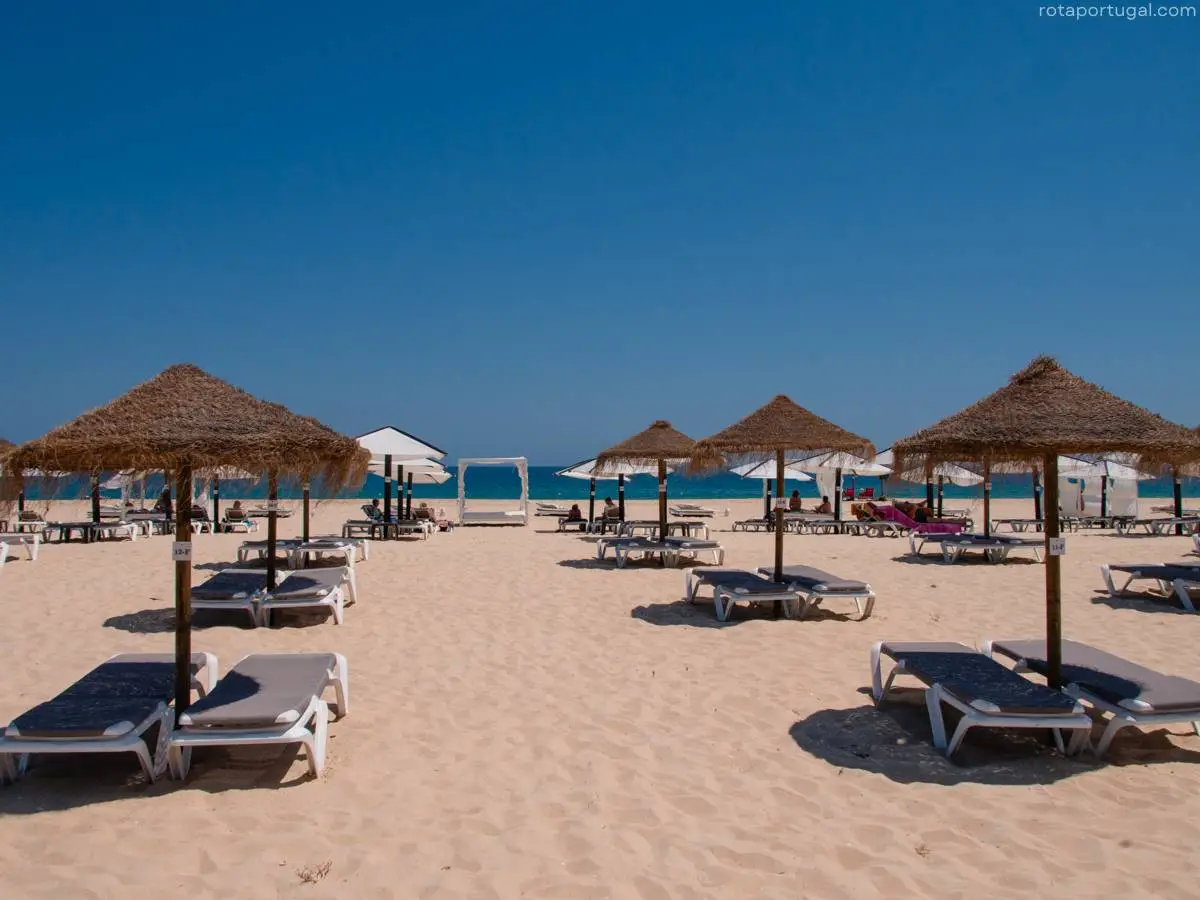
Praia da Terra Estreita
Praia da Terra Estreita is the second beach on the island of Ilha da Tavira. It’s accessible by a long walk from Praia da Ilha de Tavira, or by boat from the small village Santa Luzia. Santa Luzia being a famous village for octopus. Praia da Terra Estreita is a beach is backed by dunes with Mediterranean vegetation. It remains relatively undiscovered by tourists, offering a peaceful retreat with just a single bar and offering sun loungers and parasols for rent.
Praia do Barril
The third beach on Ilha de Tavira is Praia do Baril. It’s famous for several things, a popular miniature train that makes the crossing onto the island, and a small museum from the former fishing community that inhabited the island until the 1950s. The remains of this community have recently been converted into a small museum, cafe, and the popular ‘grave yard of anchors’. A small section of dune where all the anchors have been laid out that were left by the fishing community.
The beach is incredible here, and once again very a popular beach for families. The train ride across the Ria Formosa is an attraction in itself. You can also walk across the channel here alonside the track if the train is not running, or if the queues are too long. Once again, this is a blue flag beach, with crystal clear water, life guards during the bathing season, washrooms and changing rooms, and several bars and cafes.

Ilha da Fuseta – Fuseta Island
Ilha da Fuseta, often called Fuseta Island occupies the eastern end of Ilha da Armona. Ilha da Armona being the third barrier island you’ll come across travelling from east to west. On its eastern edge its referred to as Ilha da Fuseta, taking its name from the nearby village of Fuseta.
Fuseta is a great place to experience the Ria Formosa, and it has beaches both in the lagoon, and on the island facing the ocean. Families with young children often utilise Praia da Fuseta, the beach that faces into the lagoon. It’s got plenty of parking, facilities for families, is lifeguarded, and due to its location on the inside of the lagoon the water is very calm.
More adventurous families and couples will take the ferry from Fuseta to the island. It’s frustratingly sometimes referred to as the ”Maldives of the Algarve” which is awkward but at least an attempt at describing the crystal clear waters and near white sand beaches. Just don’t expect tropical waters, this is still the Atlantic!
Discover: Fuseta – The Best Things to See and Do

Ilha da Armona – Armona Island
Ilha da Armona is the 9-kilometer-long (6 miles) island known as Armona Island, and roughly split into two parts. The eastern end (Ilha da Fuseta mentioned above) and Ilha da Armona at its western end. Armona Island is accessible by ferry from Olhão, or by walking from the Fuseta end of the island. While the Fuseta end lacks any permanent buildings or inhabitants, Armona is inhabited by a small community – which was originally a fishing village.
Armona Island village is made up of a smattering of low one story beach houses, with several bars, cafés and restaurants within in them. When arriving by ferry, you’ll walk through the village, before making your way to a stunning boardwalk that makes its way to the main beach Praia da Armona.
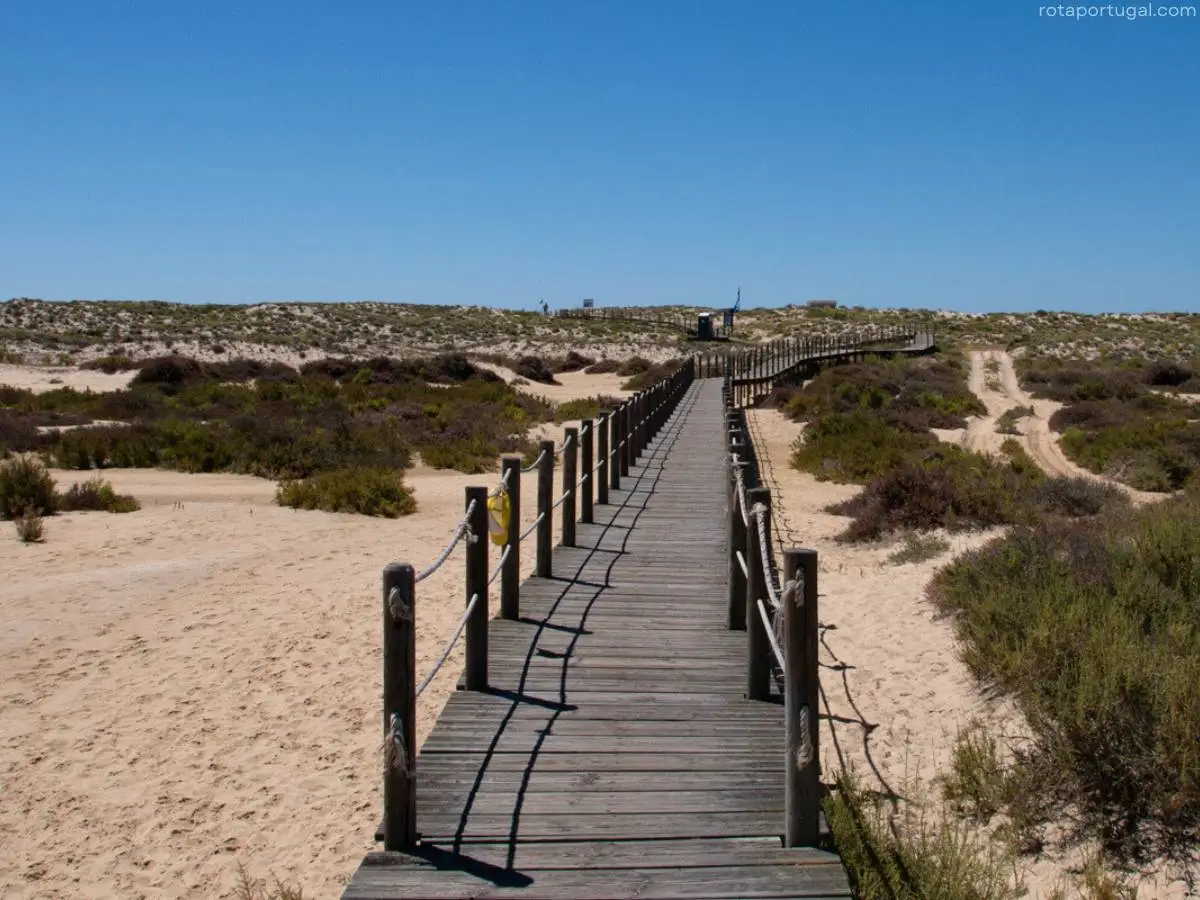
Ilha da Culatra – Culatra Island
Ilha da Culatra is the most built up of the Ria Formosa’s islands, with several small comunities spread across the island in three settlements – Culatra, Hangeres, and Farol. Ilha da Culatra usually refers to the central part of the island, with a small settlement and dock. Most ferries from nearby Olhão make a round trip, stopping at Culatra before making their way to Farol before returning back to Olhão. A great way to fully see the island is to get off the ferry at Culatra, and walk towards Farol, its around 4km (2.5 miles). From Farol you can catch a returning ferry to Olhão.
The main beach at Ilha da Culatra is Praia da Ilha da Culatra and once again its a blue flag beach praised for its cleanliness, access, and safety. Its one of the most popular beaches in the area though.
Ilha do Farol – Farol Island
The western end of the Ilha da Culatra is confusingly named Ilha do Farol. Despite the name they are not separate islands. This is the most stunning and picturesque of the Ria Formosa’s islands, with its characteristic 19th century lighthouse standing over the beach.
Praia da Ilha do Farol is the beautiful blue flag beach with facilities to support a full day at the beach. There’s a selection of bars and restaurants, and of course sun bed and parasol rental. Additionally there’s life guarded sections during the summer bathing season. During the summer, it can get very busy, but you can find quieter spots to lay down a towel and plant your own umbrella by heading east along the island.
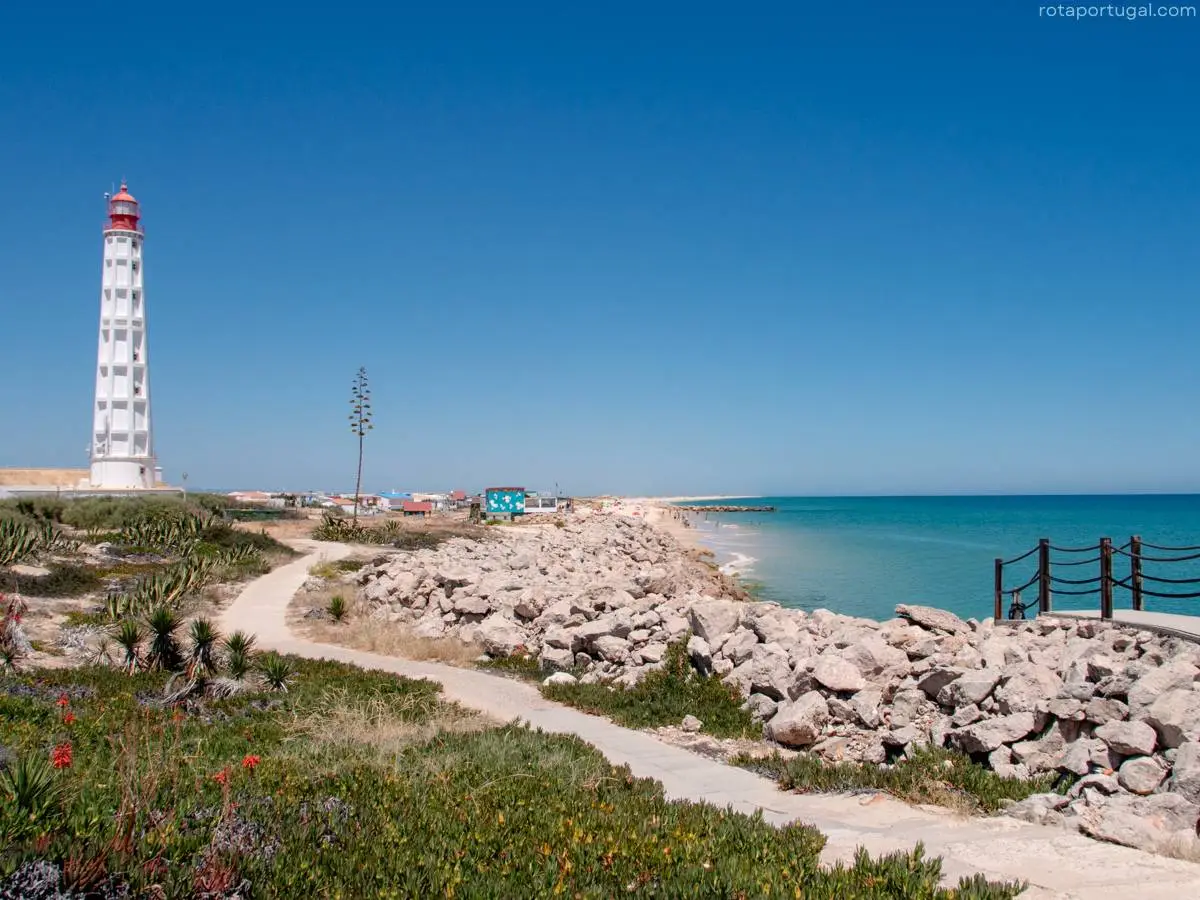
Ilha Deserta – Deserta Island
As its name suggests, Ilha Deserta is a deserted island with a pristine landscape. It’s not completely deserted, as it does feature one seasonal restaurant that also operates the sunbed and parasol rental on its beach. However, apart from these facilities, there is nearly nothing else on this island.
There is a stunning 2 kilometer-long boardwalk along the beach, and over dunes that offers stunning views, and the beach is divided into a nude section and an area with parasols and loungers for rent. A small point on its central beach also marks the most southern part of continental Portugal!
Ilha de Faro – Faro Island
Ilha de Faro, is another confusingly named place within the Ria Formosa. It’s technically a peninsular and connected by land to the west at Quinta do Lago. This is the easiest to access, and most built up of the Ria Formosa’s islands. As it is accessible by road from Faro, by boat from Faro city, and by cycling or walking from Quinta do Lago. It also has the widest range of facilities of any of the beaches in the Ria Formosa, and is perhaps the size of a small town. You’ll find hotels, hostels, bars, cafés and restaurants along the 2km stretch of built up area.
Head outside this area, to either the east or the west and you’ll find it much more undeveloped and uncrowded. Its also a popular spot for surfers, as well as for people learning to surf with a few surf schools.
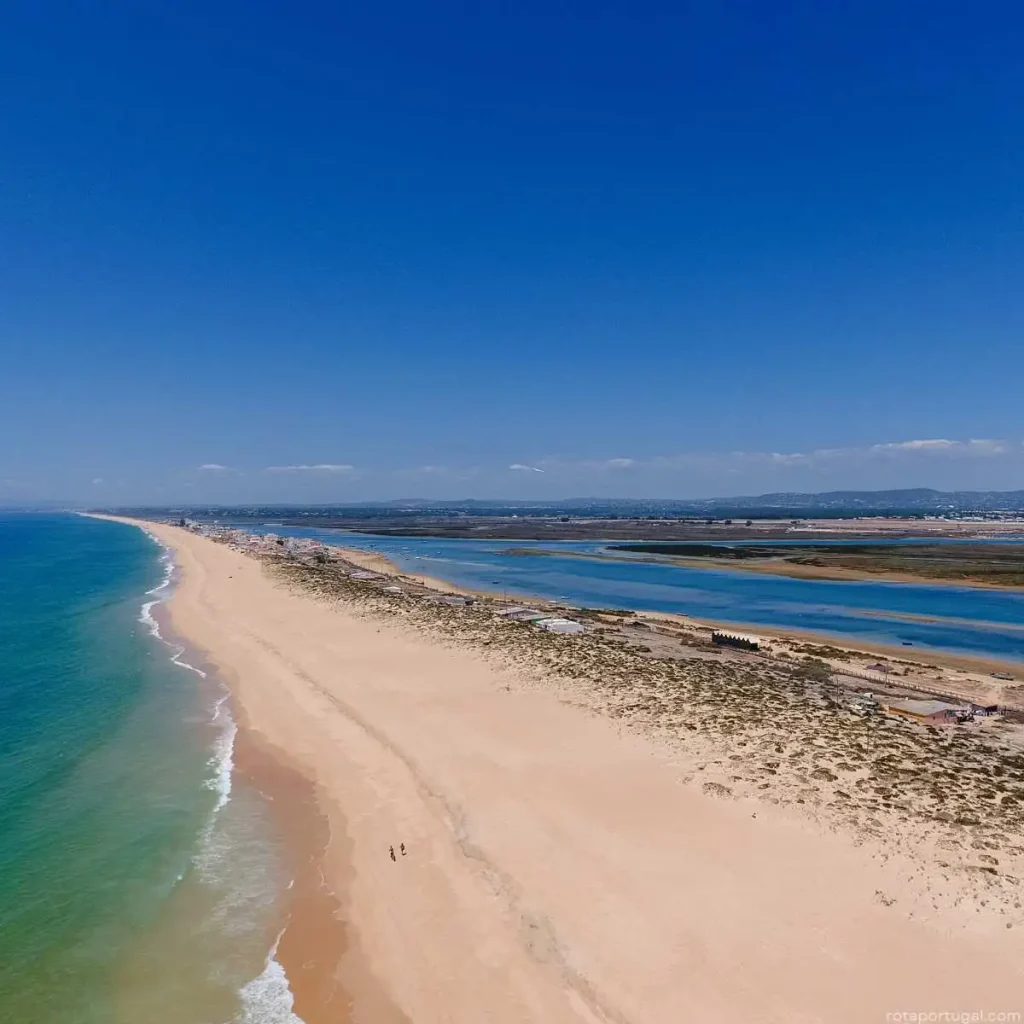
Praia da Quinta do Lago
Quinta do Lago is perhaps the most luxury and premium of the Algarve’s resorts. You’ll find five start hotels, resorts, and world class golf courses in the immediate area. It actually backs on to the far east of the lagoon. It’s beach, Praia da Quinta do Lago requires a small footbridge to cross the Ria Formosa.
It’s publicly accessible, although nearby parking is expensive at €1.20 per hour. So the beach usually attracts mostly visitors and holiday makers from the nearby resorts. There is also the well maintained São Lourenço Trail which takes you alongside a golf course, through pinewoods, lagoons, and marshes. It’s story boarded with regular signs explaining the environments, and wildlife so a great place for all the family to find out about the lagoon environment! If you’re at the right time of year, you might also get to see flamingos!
Will you be Visiting the Ria Formosa?
The Ria Formosa Natural Park is an absolute must see if you’re in the Algarve. It is one of Portugal’s natural wonders. The lagoon offers something for everyone, whether you are looking for the best beaches, wildlife spotting, or an opportunity to explore cultural sites along many of the towns and villages. Which is your favourite place in the Ria Formosa?
